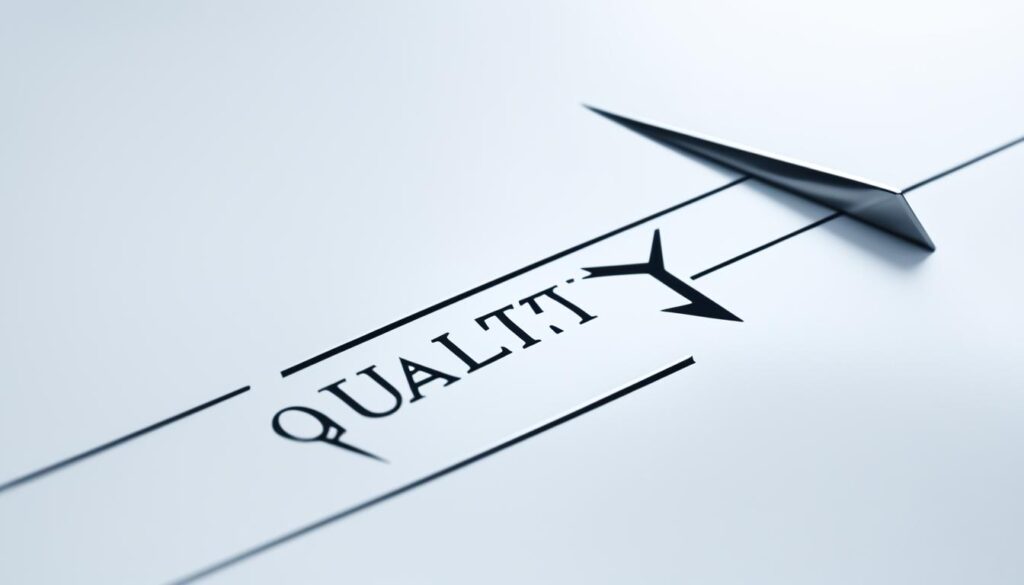Scaling a business is an exciting journey filled with endless possibilities. However, it also brings unique challenges, especially when it comes to maintaining quality. As your business grows, you need to ensure that the products or services you offer continue to meet the high standards that set you apart.
In this article, we will delve into the realm of growth management and explore the importance of quality control in this process. We’ll provide you with valuable insights, strategic growth planning, and practical tips to help you scale your business while maintaining top-notch quality.
Key Takeaways:
- Growth management is crucial for scaling your business successfully while maintaining quality.
- Defining clear quality standards and expectations is the first step in maintaining quality control.
- Implement robust quality assurance processes, including testing, auditing, and continuous improvement.
- Invest in training and empowering your team to uphold quality standards as your business expands.
- Collect and analyze customer feedback to make informed decisions for quality improvement.
Defining Quality Standards and Expectations
Clearly defining your quality standards is a critical aspect of maintaining quality control during growth management. By identifying specific criteria such as functionality, usability, reliability, security, design, and customer feedback, you establish a framework for evaluating the quality of your products or services. Documenting these standards is essential, as it ensures transparency, consistency, and adherence to quality guidelines.
Communication plays a vital role in aligning all stakeholders with the defined quality standards. By effectively communicating these standards to your team, partners, and customers, you create a shared understanding of expectations. It enables everyone involved to work towards a common goal and deliver top-quality outcomes. Regularly reinforcing these standards through clear communication also helps prevent misunderstandings and promotes a culture of excellence.
“Quality is never an accident; it is always the result of high intention, sincere effort, intelligent direction, and skillful execution.” – William A. Foster
To ensure that quality standards are met consistently, it is crucial to align them with your business goals, customer expectations, and industry best practices. Regularly reviewing and updating your quality standards documentation allows you to stay relevant and adaptable in a dynamic business environment.
When defining your quality standards, consider incorporating customer feedback as an essential component. By actively seeking and considering customer input, you can tailor your standards to meet their needs and preferences. Customer satisfaction should be a paramount consideration in your quality control processes, further ensuring the delivery of high-quality products or services.
Now that we understand the importance of defining quality standards, let’s explore effective strategies for implementing robust quality assurance processes to uphold these standards and foster continuous improvement.

Implementing Effective Quality Assurance Processes
To maintain quality control during growth management, it is essential to implement robust quality assurance processes. These processes involve testing, auditing, reviewing, and reporting to monitor and improve the quality of your work and deliverables. By implementing effective quality assurance processes, you can ensure that your products or services meet the highest standards and exceed customer expectations.
Testing: Testing is a crucial component of quality assurance processes. It involves systematically evaluating your products or services to identify any flaws, defects, or potential issues. By conducting thorough testing, you can address any issues before they reach your customers, ensuring a high level of quality and reliability.
Auditing: Auditing involves a comprehensive examination of your processes, systems, and documentation to ensure compliance with quality standards and best practices. It helps identify areas for improvement and ensures that your business operates in an efficient, consistent, and compliant manner.
Reviewing: Regular reviewing of your work is essential to maintain quality control. This involves assessing the quality of your deliverables, identifying any deviations from the expected standards, and implementing corrective actions to resolve any issues. Through constant reviewing, you can continuously improve the quality of your work and drive excellence throughout your organization.
Reporting: Reporting plays a vital role in quality assurance processes. It involves documenting and communicating the results of testing, auditing, and reviewing activities. Reporting provides valuable insights into the quality of your work, identifies trends, and helps stakeholders make informed decisions. Transparent reporting enhances collaboration and accountability, ensuring that everyone is aligned with the goal of maintaining high-quality deliverables.
Continuous Improvement: Continuous improvement is a key principle of quality assurance processes. It involves constantly seeking ways to enhance the effectiveness and efficiency of your processes, systems, and deliverables. By fostering a culture of continuous improvement, you encourage innovation, creativity, and the pursuit of excellence across your organization.
Automation: Automation can significantly streamline and enhance quality assurance processes. By leveraging automation tools and technologies, you can reduce the risk of human error, improve accuracy, and increase efficiency. Automation allows for consistent and repeatable testing, auditing, reviewing, and reporting, enabling your team to focus on higher-value tasks and strategic initiatives.
Quality Assurance Documentation: Documentation is a critical component of quality assurance processes. It involves creating, maintaining, and organizing comprehensive records of your quality control activities, standards, processes, and improvements. Quality assurance documentation serves as a reference for your team, helps ensure consistency, and enables efficient knowledge transfer.
Training and Empowering Your Team
Your team plays a crucial role in maintaining quality control during growth management. Investing in their training and empowerment is vital. By providing ongoing team training opportunities, workshops, and resources, you can keep your team updated on industry trends and best practices.
A feedback culture is essential for continuous learning and improvement. Foster an environment where team members feel comfortable sharing their ideas and suggestions for enhancement. Encourage collaboration among team members, allowing them to contribute their unique perspectives and expertise.
“Alone we can do so little; together we can do so much.” – Helen Keller
A collaborative approach fosters creativity, problem-solving, and efficiency. Encouraging open communication and creating channels for feedback and discussion will lead to valuable insights and stronger outcomes.
Recognize and reward your team members’ quality achievements. Acknowledge their hard work and dedication to quality standards. By doing so, you motivate and inspire them to consistently deliver exceptional results as your business scales.
Empowering Growth Through Skill Development and Knowledge Enhancement
Empower your team by providing opportunities for skill development and knowledge enhancement. Offer specialized training programs, mentorship initiatives, and access to industry resources. This enables your team members to expand their expertise, stay updated with the latest trends, and acquire new skills that contribute to success in a rapidly evolving business landscape.
Encourage a culture of continuous learning by promoting self-improvement, fostering curiosity, and providing platforms for sharing knowledge within the team. Emphasize the importance of staying updated with market trends, emerging technologies, and best practices to ensure your team’s resilience and ability to adapt to changing circumstances.
Incorporate a feedback culture within your team, where constructive feedback is given and received openly. Create feedback channels and regular performance evaluations to nurture a growth mindset and support personal and professional development.
Collaboration is key to empowering your team. Enable cross-functional collaboration, encourage teamwork, and facilitate knowledge sharing. By leveraging the diverse skills, experiences, and perspectives of your team members, you can achieve greater innovation, efficiency, and quality in your business operations.
Collecting and Analyzing Customer Feedback
Customer feedback is a valuable resource for maintaining quality control and ensuring customer satisfaction. By regularly collecting and analyzing feedback, you can gain insights into your customers’ needs, preferences, and levels of satisfaction. This information allows you to make informed decisions, identify areas for improvement, and enhance the overall quality of your offerings.
There are various methods for collecting customer feedback, including surveys, reviews, interviews, and social media interactions. These methods provide diverse perspectives and allow you to gather feedback from different channels. By leveraging a combination of these methods, you can gather comprehensive data to inform your quality improvement initiatives.
Once you have collected customer feedback, it’s crucial to analyze it effectively. This involves categorizing and organizing the feedback based on common themes or topics. By identifying patterns and trends in the feedback, you can pinpoint areas of strength and weakness in your products or services.
A key aspect of customer feedback analysis is the feedback response. It’s essential to acknowledge and respond to customer feedback promptly. A timely response demonstrates your commitment to quality and customer satisfaction. Additionally, responding to feedback provides an opportunity to address customer concerns, resolve issues, and showcase your dedication to continuous improvement.
Implementing a system to track key performance indicators (KPIs) and performance metrics is essential for monitoring the effectiveness of your quality control efforts. By tracking and measuring customer satisfaction levels, you can assess the impact of your quality improvement initiatives over time. This data helps you understand the success of your customer feedback-driven quality enhancement strategies.

By effectively collecting, analyzing, and responding to customer feedback, you demonstrate your commitment to quality and customer satisfaction. This builds trust, loyalty, and a positive brand image. Moreover, it empowers you to make data-driven decisions and continuously improve the quality of your offerings.
Conclusion
Scaling a business while maintaining quality is a challenging but essential endeavor. In order to achieve sustainable growth and scalability, it is crucial to prioritize quality control. By carefully defining clear quality standards, implementing effective quality assurance processes, and continuously training and empowering your team, you can successfully manage the growth of your business while ensuring top-notch quality.
It is important to recognize and mitigate the risks associated with business expansion. Strategic planning and risk management strategies can help minimize potential pitfalls and ensure a smooth scaling process.
Measuring the success of your scaling efforts is key to evaluating your performance and making informed decisions. By establishing and tracking key performance indicators, you can determine the effectiveness of your growth management strategies and make necessary adjustments to sustain long-term growth.
In conclusion, scaling a business requires a careful balance between growth and quality control. With the right strategies and mindset, you can achieve scalable growth while maintaining exceptional quality standards. By constantly reviewing and updating your quality control system, you can build a solid foundation for sustained growth and create a successful business that meets the needs and expectations of your customers.






